I believe the title of this info from Woman's Day says it all!
Wednesday, July 5, 2017
Saturday, June 24, 2017
8 Steps to Effectively Share your Message Step #8: Have Others Share Your Message

I had thought of calling this step Get Someone Else to Do It but decided to be more tactful. It is however, your goal.
My favorite part of Tom Sawyer is when Tom is told to paint a fence & he motivates other boys to do it for him. What an incredible example of leadership! It's a hot dirty job & he manages to make it look inviting, so inviting the other boys BEG him to let them do the job!
An Inventive & Effective Leader
This is clever on so many levels. First, Tom knew exactly who he needed to recruit for the job at hand. Second, he made a dirty job look good. Tom gave those boys a vision of the mind-numbing job of fence painting look so good they BEGGED to do it for him! Third, while it would have take Tom alone a long time to finish painting the fence, the group of boys churned it out in no time. Dividing up the work assigned to 1 person among a group people made the task easier & quicker to accomplish. Fourth, while Tom had to get the ball rolling, beginning the painting himself, once he recruited others to help out, Tome was able to sit back & let the work continue without his help.
Following Tom's Example
Now, I know Tom Sawyer is not used as an example of effective leadership, although perhaps he should be. You can however, learn a lot from Tom's example, discovering ways to promote & share your message by getting others to do it for you.
Recruit the Right People
First, you have to determine who the right people are to recruit for the job. Look for bloggers, podcasters, etc that have a message that compliments yours. It might be on a topic you have considered using but felt it would pull you too far off your focus. This allows you to offer your market information you would like to create without having to spend the time researching & writing. Once you have found a few people, you want to recruit them to help you share your message with their audience.
Make It Look Good
Tom made a hot dirty job look good which encouraged the boys to ask to help. You need to made the job of sharing your message look good to others so they willingly offer to do it. How? By showing them what's in it for them. You want to create a partnership with them that is mutually beneficial. Contact them & ask if you can share their site, material, broadcasts, etc with your audience. If you have a podcast, ask about interviewing them. When you post the material, be sure to send them the link. I like working with women that are just starting out. They are so excited for the exposure & I like helping them. When the article, post, program is available, they share the link with EVERYONE THEY KNOW! This drives new people to your material. Be sure to provide links to your other resources so visitors can learn more about you.
You can also share links to their sites on your site in exchange for them doing the same for you. Or share their book, program whatever in exchange for doing it for you. This is all mutually beneficial.
Many Hands Make Light Work
Finding the right people & sharing their material or interviewing them takes time. Eventually though, it makes less work for you. The more people you help, the more people you are able to reach. Tom could have recruited 1-2 boys to paint for him. Instead, he recruited a group that should have been able to knock the job out in no time. It took time for him to recruit that many boys but it paid off in the long run. It will take time for you to recruit the right people but it pays off in the long run. The people you help drive a new audience to your sites without you spending any money. You must simply invest the time at first.
Finally, They Come to You
After Tom had recruited a few boys to paint, I imagine other boys began to show up ASKING if they could paint too. tom would no long need to recruit helpers. They would come to him, wanting to participate.
The same thing will happen to you. At first, you will need to find people whose material you can promote. You will need to keep doing it day after day. Eventually, however, you will reach the tipping point where the process takes on a life of its own. It happens slowly at first. Just one person here & there asking you to share their message. Drip, drip, drip until the rush begins. Soon, your mailbox is filled with people asking to be interviewed, wanting you to share their book, seeking to have you promote their site.
At this point, like Tom, you can sit back & watch the work continue without any effort on your part. Well, almost. You still have work to do. However, your listeners, subscribers, numbers continue to grow without any effort on your part. All you need to do is help other people & continue to create new content. Not bad, huh?
In Conclusion
So, there you have it. It takes time to go through the entire process. Not every message will need the entire process. Let's face it, not every blog post can be turned into a book! You can, however, follow the steps as far as each topic takes you. This systematic way of building on your message saves you time & helps you focus & grow your brand with less stress & greater success!
Friday, June 23, 2017
8 Steps to Effectively Share a Message Step #7: Develop a Keynote/Workshop
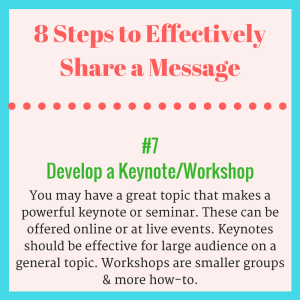
At this point, you have been working on this topic for quite awhile. You've shared it on your blog, written a booklet, done podcasts & more. Now it's time to share it with a live audience.
PRACTICE-PRACTICE-PRACTICE
Whether you speak to your audience in person or on the internet with a webinar, you need to be certain your message is ready to share. You can always go back & edit everything you have done up to this point. You can't edit what you said during a live presentation once that presentation is over. You CAN record each presentation, FORCE yourself to listen to it & discover ways to improve either the material or presentation of that material.
Never Rush It
I know it's easy to jump into doing a live presentation right away. We all over the thought of adoring fans hanging on our every word. This ego boost is what gets most people over their fear of public speaking. You must, however, wait until your message is finely tuned before you share it with a live audience.
Keynote or Workshop
How do you know whether your message should be a keynote or a workshop? I always look at keynotes as being inspirational. They may encourage you to take action, may even offer you steps to help you TAKE that action. During a keynote, people tend to listen more than write. During a workshop, people take notes. A workshop is a how-to session, teaching people ways to take specific action in a step-by-step presentation. You can use the same material for both.
About Keynotes
The keynote needs to be a trimmed down version of your material. It should encourage your audience to begin the process outlined in your material. It should offer people enough information that they might put your advice to work, even if on a limited basis. For those wanting more information, your keynote should encourage them to purchase your book without sounding like an infomercial. In other words, leave them wanting more!
About Workshops
Your workshop should also leave them wanting more. While it is more detailed than a keynote, you don't need to share EVERYTHING that's in your book. Find helpful ways to point out the additional information that can be found on your blog, podcast & books.
It All Prepares You for This!
Speaking to a live audience enables you to connect more directly with your market. You must however be prepared personally & with your material before you step in front of the microphone! Every other step before this prepares you AND your message to do the job well!Thursday, June 22, 2017
8 Steps to Effectively Share a Message Step 6: Produce Podcasts/Videos
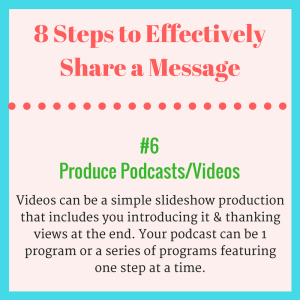
Developing a personal connection with people in your audience helps promote your message. People like to buy from someone they know. When they feel they have gotten to know you, they want to learn more, either through other material you have created or by buying your books. A podcast & videos are a great way for people to get to know you.
Look at Me!
When I first began writing, I wanted a radio show & my own television show. I was THRILLED when the internet made all this possible & at no cost! Oh, I've spent money on these things over the years but I have found through trial & error that the free platforms work just fine for my purposes.
Short is Very Sweet
When I began my first podcast, I wanted to offer a 30 minute program once a week. Mr. D, my hubby, advised me to keep it much, much shorter. At the time, a 30 minute program would have taken too long to download for most of my audience. In addition, most of them didn't want to listen to a long program on their computer. So, I broke each 30 minute program into a 5 part series with each part only 5-6 minutes long. This length was perfect.
I have done longer programs over the years but I am currently going back to shorter program. Blog Talk Radio allows me to host a 15 minute program each day & it's FREE. I can do it live or record it & upload. This is the perfect length for both me & my listeners.
Never Let it Overwhelm You
Videos can seem overwhelming but they don't have to be. I often make movies out of slideshows. This enables viewers to stop the video & read a recipe or instructions.
I also like doing short videos, short like my podcast. There are so many places where I can record & upload or do it live. YouTube has expanded to offer so many ways to produce & share your videos with your audience. You can create a series that focuses on your current topic, like when I produce videos for Thanksgiving. You can create playlists on each topic to make it easier for your viewers to find the videos they want to watch.
Share, Share, Share
Once you have produced & uploaded your podcast & videos, share them on your blog/website. You want to share them in as many places as possible. You also want to share your series links on the program info. ALWAYS share links to all the material for the series in each different format. Each post, podcast, booklet, book, etc should refer your audience to other formats.
Make all your materials work for you. This is the best way to make all that hard work pay off!
Wednesday, June 21, 2017
8 Steps to Effectively Share a Message Step 5: Create a Digital/Print Book

You created a booklet & began offering it on your website & on your product table during presentations. The response has been great. People are reading the material & asking questions, making comments. You have been doing research, open to more information on the topic. You add to your notebook containing material on this message. After careful consideration, you decide it's time to create a full book.
Start Digitally
There is no better feeling for an author than holding a print copy of their book in their hands. It's also great walking into a bookstore & find their book on the shelf. As desirable as these two experiences are, I want to strongly recommend you not rush into having a print book, whether you self-publish or sign a contract with a publishing house. The first thing you want to do is go digital.
A digital book enables you to write a full-sized book without the expense of printing. Printing is very expensive. Also, printing is final, more or less. Digital books offer you flexibility.
Digital Flexibility
No matter how many times you go over your manuscript, you ALWAYS find things you want to change after your book has been printed. New information becomes available. You think of things you want to add. You don't like the way you worded certain things. You might be able to eventually make changes in your book should it ever be considered for a revised edition. Or you just might have to live with those desired changes.
Or, you release your book in a digital format first, giving you the opportunity to make any changes you want to make before the manuscript goes into print. You are even able to take a different approach to the material at this point. A message that worked well all the way up to a booklet may begin to break down once you expand it into a book. The digital book causes flaws to rise to the surface BEFORE you commit the material to print. A digital book can be your best friend, your most powerful tool in this entire process. It can save you the heartburn of struggling with a print book
Now You Can Print
Once you have the manuscript as close to perfect as you can get it (you will never be COMPLETELY satisfied), you are ready to create print copies. Now, I have strong opinions about whether authors should find a publisher or self-publish. I am not, however, going make my case one way or the other in this post.
If you decide to go with a publisher, you should begin the process early on. You might find a publisher when you first develop the idea. Or you might need to show the popularity of your message by offering sales #'s to potential publishers.
If you decide to self-publisher, there are so many more options than when I had my first book published. In addition, self-published books get more respect today than they did even 10 years ago.
You really need to do your homework to determine which option is better for you & your book. Which ever option you choose, remember, the success of your book always rests in your hands!
Tuesday, June 20, 2017
8 Steps to More Effectively Share a Message Step 4: Create a Booklet

You might believe this is an unnecessary step. You would be mistaken. A booklet serves many purposes in this process. Let's see what some of them are:
Allows You to Expand Your Message
Your blog series should contain plenty of useful information. You never, however, want to put everything about a topic into any one piece of the process until you get to your book. And even then, you want to be able to refer readers to other formats, like a video or podcast, for even more information. Anyway, while your blog series is more detailed than the infographic, you should have more information to share. I find once I write my blog posts, I begin finding other information to support my message. Or people write comments that offer information or ask questions that help me see areas I need to further develop. A booklet allows you to do this.Quick to Put Together
You might scoff at creating a booklet, preferring instead to wait until you complete a book. A full length book may take 6-12 months to complete. A booklet can be finished in a weekend. This doesn't mean you simply throw it together. You always want to create a quality product. Some items, however, can be created in a shorter amount of time than others.Easy to Giveaway
I always produce a digital version before I have a print version made. A digital version can contain hot links to your blog, your podcast, videos, social media & third party supporting information, like a book that adds on to your message. A digital booklet makes an excellent giveaway for people that subscribe to your mailing list. I just add the PDF to my website & make that the landing page.A Quick New Item for Your Product Table
If you are really hot on your topic, you want to share it with people as quickly & easily as possible. A booklet allows you to have a physical product to sell when you do events. Your booklets may contain all the information some people want. They are also an inexpensive way for members of your audience to take a piece of you home with them at a low cost. When you do a bang-up job during a presentation, people like having a memento for lack of a better word, to take home with them. While books can be expensive, a booklet is usually only a few dollars. You may find your booklets are the best selling item on your product table.It Is More Forgiving
There is nothing worse than spending months-years writing a book, having it printed only to discover all the changes you want to make. It's always hard to let go of your book once you are done writing it. You always want to do MORE! I'm talking about major changes. Info you could have added. Mistakes. A booklet allows you to see where there are holes & gives you the opportunity to fix them. And at a much lower cost then a book. I only print a few booklets at a time so I can make revisions as necessary. Now you can see how important a booklet is in this process. It is well worth the time & minor expense to produce a booklet, ensuring your future book is filled with even more valuable information than you thought possible.Monday, June 19, 2017
8 Steps to More Effectively Share a Message Step 3: Develop a Blog Series
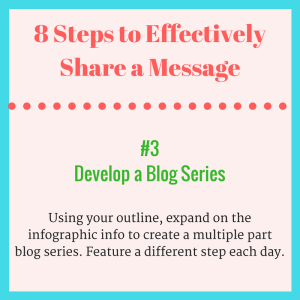
Is the Subject Expandable?
Once I create an infographic, I like to create individual blog posts for each step. This enables those that want to get more information on the topic. It also enables ME to determine if I have enough material to write a book. If I can't do a decent blog series, then I'll never be able to come up with enough info to write a book.
A Path to Podcasts & Videos
The blog series also helps you begin the process of creating podcast & video material. I simply take the info from a blog post or series, add to it where necessary & go into production. Depending on the length of each post, I might do either one long program or break it down into smaller pieces just like the blog series. I learned early on to keep audio & video short to give my busy audience the opportunity to listen & watch. I can always put the segments together & make one long program. More on this later!
Design Graphics for Blog & Social Media
At this time, I also create the graphics I need for the blog series. You can see an example at the top of the page. In Canva, I design the first piece & then make copies for each additional post. This is also when I design graphics for social media. I want to share the blog posts in as many places as possible. Designing graphics for Twitter, Facebook & more gives my series a consistent look across the board. Canva offers templates for various platforms so this is easy to do.
Determine the Best Time to Post
I prefer to share the posts from a series M-F. This gives readers time to catch up on the weekend if necessary. I have also found that I have the most readers during the week for this type of post.
Developing a blog series from the steps on an infographic is a great way to expand on a good topic & discover other ways you can use the information across platforms & formats.
Wednesday, June 14, 2017
8 Steps to More Effectively Share a Message Step 2: Create an Infographic
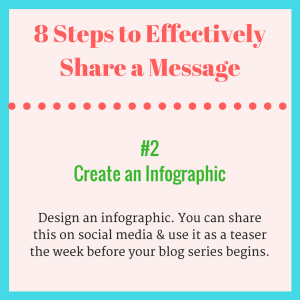
Once you have created your outline, it is simple to design an infographic. This is a, well, graphic that basically has your outline on it.
Like this:
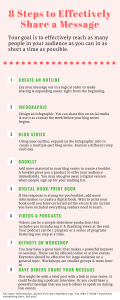
I use Canva to design my infographic. They have many free designs from which to choose, including designs for infographics. The great thing about Canva is you can choose a template for the specific use & it is the right size for that format. For example, if you need a new header for your Facebook page, they have a template for that as well as a Twitter header, etc. You don't have to guess what the correct size is for your need.
Design Graphics at One Time
I try to design various graphics at the same time so they all match. Yes, I know how OCD that sounds. Guilty! This, however, enables me to brand each series I create. You notice the infographic & the blog graphic have the same colors & line design. Ta-da! I am also able to design a graphic for Facebook, Twitter, Linkedin, & more. All the same design that has been plugged into a new template.
Creating the Infographic
The infographic is basically my outline. I make sure it has enough information so anyone that only sees this one part of the process is able to apply the lessons offered in the infographic. I ALWAYS make sure each step of this message sharing process not only supports & builds on all the other steps but is able to stand alone & help my audience, even in a limited way. An infographic doesn't offer a whole lot of information but I make certain that small paragraph is powerful. And hopefully causes the reader to want to learn more.
Why Bother?
So why bother with an infographic? First, you can use it as a teaser for your upcoming series. Share it on social media the week before your series begins. I also share it on Pinterest with a teaser before the series begins & then again with a link to my blog once the series has started. I pot it on my blog to let subscribers & potential subscribers know this series is coming. I send it to my mailing list. And on & on.
Rack Cards
You can also have your infographic printed as a rack card that you place on your product table when you have a speaking engagement. Rack cards give your audience a free takeaway that invites them to visit your blog for more information.
As you can see, infographics play an important role in the process of effectively sharing your message & are well worth the time to design.
Tuesday, June 13, 2017
The Problem with Guilt Part 1: Guilt Implies We've Done Something Wrong!
I LOVE Law & Order. I watch it on one of the local stations every Wednesday & Thursday. I watch other crime shows as well but Law & Order allows me to see the police do their job & the prosecutors do their job. So I see courtroom action every episode. Most episodes, at some point, a judge asks the defendant, "How do you plead?" And they have to say Guilty or not guilty. Most of the time, they say not guilty so the show can continue rather than ending early! 😊
Funny how even the most guilty person pleads not guilty in the hopes they can get away with whatever crime they are accused of committing. Not so much with mommies. We tend to plead guilty over the most minor infraction. And most of the time, WE AREN'T EVEN GUILTY OF ANYTHING!!!!!
As I see it, guilt implies we have done something wrong. Not just wrong in our own eyes but wrong according to society standards. If a person cheats on their spouse, they are guilty of adultery. Not passing judgement here. Just saying this sort of behavior should be avoided. If a parent mistreats a. Hold, especially to an extreme, they are guilty of abuse. This is just NOT acceptable behavior.
If however you are unable or unwilling to buy your child the newest toy that EVERYONE has, you may feel bad but you should NOT feel guilty. You haven't done anything wrong. Your kids may disagree but they would be wrong!
I believe most of the time we feel guilty, what we really are is afraid. We fear what others may think. We fear what they may say. We fear we might be harming our children. And to make matters worse, we going onto the court of public opinion, known as social media, and display our sense of guilt so other may judge us. And judge us they will. I have never seen so many glass house residents throw around so many stones! Perhaps it makes others feel less guilty when they judge others.
All I know is we need to stop calling it guilt. The more we tell ourselves,how guilty we feel, the more we reinforce our feelings of inadequacy & failure. Which only makes us feel more guilty, more afraid.
So, to begin this journey away from guilt, become more aware when you tell yourself how guilty you feel and, as Barney Fife would say, " Nip it in the bud!"
8 Steps to Effectively Share a Message: Step 1 Create an Outline
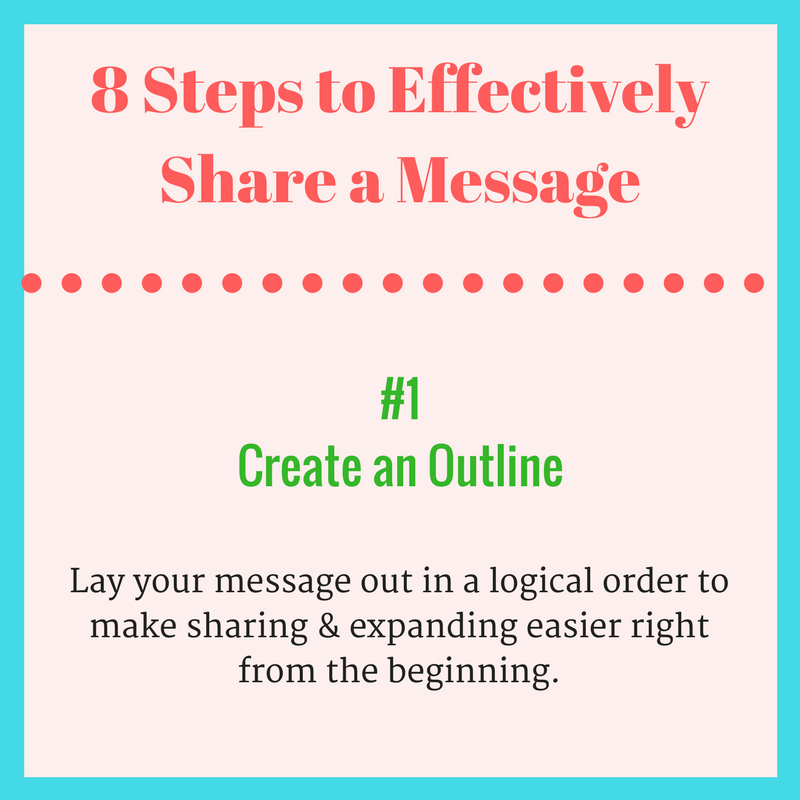
I could hear you groan, you know! Outlines seem tedious. Perhaps you never had to learn about outlines in English class. They were a pain! Breaking things down into smaller & smaller pieces with very specific tags to identify their place in the outline. It was painful & confusing.
Not Your English Class Outline
This is not that type of outline. When I began as a speaker & author, I studied under Florence Littauer. We were taught that outlines help us formulate the message in a logical order. How many times have you listened to a speaker that motivated & inspired you yet later, you were unable to share anything they said in their presentation? The speech might have been very well written but if it wasn't created in a systematic format, your brain is unable to retain the information.
Is There Enough for a Series?
When I come up with a great topic, like this one, the first thing I do is create an outline. This enables me to see if I am able to develop a message from the idea. If I can't flesh it out into a simple outline, then I know I only have an informational graphic to share on Instagram.
It's Easier than It Sounds
You want an outline that makes it easy for your readers or listeners to remember your material & easy for you to share it across multiple formats. An outline makes it easy for me to first create an infographic & then break it down into a blog series.
Your outline is easy to create. Pick a word that represents your message & make an acrostic. For example, TALK: Teach, Act, Listen,Keep. Or you might you words that rhyme: Make, Take, Wake. You can use an analogy. To share my Simple Joy message, I created a message using a tree through the seasons. It takes some effort at first but it becomes very easy, very quickly.
Well Worth the Effort
Take the time to develop an outline & you have the foundation for a message that can go from infographic to book!
Monday, June 12, 2017
8 Steps to Effectively Share a Message: Introduction

You come up with a great idea for a topic. You believe it can help many people. The question is, how do you make certain the people that can benefit from your topic have an opportunity to see it? I believe the most effective way is to share your topic across a variety of media. Sure, you say, that sounds great but WHO HAS THE TIME?
Sharing your great idea through a variety of formats doesn't have to be time consuming or expensive. By following a systematic process, you are able to easily adapt your topic over time without spend much money or even any money at all.
In this series, I show you how to take a simple idea & over time, evolve & adapt it for your audience. The great part about this process is, you can have a message on one step while working on another message on a different step. This allows you to have more than one project going at once without losing your mind!
Now more than ever, people are looking for practical guidance & hope. Rather than wasting time thinking about it or struggling to perfect it, you need to follow Nike's advice & JUST DO IT! You may be amazed how much your can accomplish in very little time.
Sunday, June 11, 2017
Subscribe to:
Comments (Atom)



